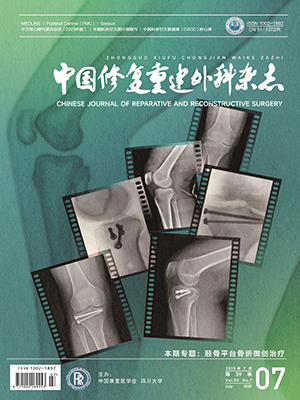To explore the method of inducing axial vascularization in a processed bovine cancellous bone scaffold by using an arteriovenous loop, and to evaluate its effect of vascularization. Methods Custom-made processed bovine cancellous bone discs were processed into cyl inder with circular grooves. Thirty male SD rats weighing 300-350 g (3-4 months old) were randomly divided into 2 groups (n=15 per group): experimental group in which the femoral veins in the groin of rats were separated and transplanted to the contralateral femoral artery and vein stump, the processed bovine cancellous
bone scaffold was inserted into the arteriovenous loop, which was placed into the annular groove. Control group, in which the blood vessels in the groin of rats were cut, no anastomosis was conducted, and the processed bovine cancellous bone scaffold was planted. At 2, 4 and 8 weeks after operation, gross observation, ink infusion histology observation and microvessel bulk density detection were conducted. Results At each postoperative time point, the samples in the experimental group were fresh red, the circulation of blood vessels were smooth bidirectionally, while the samples in the control group were dark red soft, and flexible. Ink infusion histology observation showed the processed bovine cancellous bone scaffold in the experimental group had obvious vascularization, the blood vessels tended to be mature and integrated into network, and neovascular sprouts originated from arteriovenous loop were evident, especially at 8 weeks after operation; while there was no vascularization in the control group. At 2, 4 and 8 weeks after operation, the bulk density of the microvessels in the experimental group was (3.59 ± 1.84), (16.61 ± 10.23) and (39.04 ± 13.46) μm3/μm3, respectively, and it was (2.43 ± 0.97), (6.79 ± 2.92) and (25.31 ± 10.98) μm3/μm3, respectively, in the control group. Significant differences was noted between two groups at 4 and 8 weeks after operation (P lt; 0.05), and no significant difference was evident at 2 weeks after operation (P gt; 0.05). Conclusion Inducing vascularization in a rocessed bovine cancellous bone using an arteriovenous loop is a new strategy of prevascularization and may provide valuable clues for the preparation of functional artificial bone
Citation: WANG Fengliang,LIU Jian,ZHAO Guangyue,MENG Guolin.. INDUCTION OF AXIAL VASCULARIZATION IN PROCESSED BOVINE CANCELLOUS BONE SCAFFOLD USING ARTERIOVENOUS LOOP. Chinese Journal of Reparative and Reconstructive Surgery, 2009, 23(6): 694-697. doi: Copy
Copyright © the editorial department of Chinese Journal of Reparative and Reconstructive Surgery of West China Medical Publisher. All rights reserved




